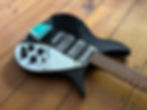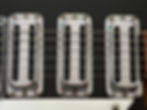1988 Rickenbacker 325 V63, as made famous by John Lennon
The short-scale, three pick-up 325 that Rickenbacker presented to John Lennon when The Beatles first landed in the States in 1964, immortalised live and in the studio on A Hard Day's Night, Help! and Rubber Soul, and beautifully recreated in this Rickenbacker 325 V63 from 1988.
Honestly, this must be the most famous short-scale electric guitar in the world. With 21" from nut to bridge, this guitar qualifies as a 3/4 size student guitar. And it might even have cornered that specific market, were it not for a 20-year-old John Lennon popping into a guitar store in Hamburg in 1960, seeing a 1958 Rickenbacker 325, and deciding it was the one for him. The story of that original 325 – and all the changes applied along the way – is documented at length by far greater experts than me. Check out Glen Lambert’s An Evolution That Produced A Revolution in particular for a clear and myth-busting step-through history of the natural-finished 325 that first caught Lennon’s eye - and stayed with him well beyond his days with The Beatles. Never lost or stolen, as sometimes reported, and even used to record parts of his final album, Double Fantasy. A guitar for life.
As far as Beatles’ performances go, it was there when they kicked off The British Invasion, playing to over 70 million viewers with their first three appearances on The Ed Sullivan Show in February 1964. And it was during that first visit to the States that Rickenbacker presented John Lennon with a a new 325 in Jet-glo black. He put it to good use . . . in the studio on A Hard Day’s Night, Help! and Rubber Soul, and, to complete the circle, The Beatles’ final live appearance on The Ed Sullivan Show, broadcast on 12 September 1965 - a not inconsiderable set including I Feel Fine, Ticket To Ride, and Help! just for starters.
John Lennon hasn't been the only one to make the 325 his own. The great John Fogerty from Creedence Clearwater Revival and The Bangles' Susannah Hoffs have both famously made this guitar a cornerstone of their careers. But it’s hard to resist a British Invasion, and Lennon's 325s were the perfect candidates to launch Rickenbacker's vintage reissue programme in 1984, coincidentally 20 years on from them handing that Jet-glo model to him in 1964. History worth repeating, or as someone else put it, it was 20 years ago today.
See & Hear It In Action

-
The Beatles On The Ed Sullivan Show: Recorded on 14 August, broadcast on 12 September 1965. John Lennon kicks things off with that riff from I Feel Fine, playing the same 325 that Rickenbacker presented to him on The Beatles' first trip over to the States in 1964. Magic!
-
Spot The Difference: Two 325s - The V63 vs The C64:: One for the geeks, but this is great! Guitar Gear Connection compares the subtle difference in sound behind the 325 V63 and the 325 C64 that replaced it in 2002. And if you want to know why that might matter, read the Further Information below . . .
Feedback
Hard Day's Night? Bad Moon Rising? Manic Monday? This one's got you covered.
Specification
Make
Rickenbacker
Model
325 V63
Colour
Jet-glo
Year
1988
Serial Number
B1 9679
Number of Frets
21
Fretboard
Varnished Bubinga (African Rosewood)
Neck
Maple
Body
Carved Maple
Tuners
Schaller Deluxe G-Series
Pick-ups
Rickenbacker Toaster Single-Coil
Bridge
Rickenbacker Bridge & Cover
Tailpiece
Rickenbacker Ac'cent Vibrato
Scale Length
21"
Full Length
34.625"
Further Information:
-
Launched in February 1958, the 325 was the first of the classic Rickenbacker Capri range, twelve thin hollow-body models that epitomise the Rickenbacker look and sound we all know and love. Who knows why the first Capri out of the workshop was a short-scale guitar, but it was only a matter of months before the full 12- guitar line-up - both short- and regular-scale - was showcased at NAMM in the summer of 1958.
-
The short scale is one thing, but the rarer feature - of both the 1958 and 1963 models Lennon played - is the lack of a soundhole. It turns out that Lennon's 1958 325 is likely only the second production Capri ever made. And those very first ones had no soundhole. An omission that Rickenbacker might have regretted - it didn't do visible justice to the craftsmanship involved in carving out the hollow body, and, worse than that, made the guitar look like one of those lower quality solid-bodies . . . Tell that to anyone trying to get hold of a 1958 Les Paul Burst today ;-). From all I've read, I still can't work out exactly when an f-hole became optional or even standard on a 325. Some say as early as 1958, some say as late as 1961 as an option, and standard on 325s from some time in 1964. If anyone is that bothered, and has the definitive answer, let me know!
-
Whenever the decision was made, it was still a feature of the Jet-glo 325 that Rickenbacker handed Lennon in 1964. And so, also replicated in this 325 V63. As is, at least visibly, pretty much every other feature of the original (with the useful exception of the tremolo bar that Lennon bent out of shape at some stage). Under the covers, the Ac'cent vibrato system has been simplified without compromise to ease use and keep the guitar in tune.
-
The more expert reviewers lamented the fact that the modern pick-ups in the V63 were wound to a higher output than the 60s 325s - to the extent that some owners have had the windings in their pick-ups reduced to achieve a closer match to that higher frequency 60s sound. Rickenbacker recognised this difference with the introduction of the lower wound 325 C64, which replaced the V63 in 2002. It's a subtle difference - and easily moderated with your amp's EQ, without having to take the risk of rewinding your pickups!
-
To play, that shorter scale does take a little getting used to - not just because of the narrower space between the frets, but also because there's a lot more play in the strings. It's easy to overbend. To be fair, you can get that same disorientation switching from a Stratocaster to a shorter scale Fender Jaguar or Mustang. All it really takes is a few minutes to get used to before you've forgotten there's a difference at all.
-
And only a few minutes after that, you'll be picking out your favourite riff from that inexhaustible back catalogue. Well, nearly. I chose I Feel Fine, played along to the original, only to realise I'd been playing the riff wrong for years . . . The good news is, the guitar made me do it right. Incontestable proof that this guitar can make you play The Beatles better ;-).
Sources & Links
-
All You Need To Know About the Rickenbacker 325: In digestible format, with thanks to Vintage Guitar Magazine - though, to be fair, at 5' 10", Lennon wasn't small . . . just saying ;-).
-
An Evolution That Produced A Revolution: Curated by the brilliant RickResource, a more detailed deep-dive into John Lennon's first 325, with Glen Lambert's step-through of the spec, history and modifications to that first 325 that caught John Lennon's eye in 1960. It brings the story up to date to 2002, which explains why Lennon's J-160E, found in 2013, was still lost at the time of writing. But as a story-so-far, this is just wonderfully researched!
-
Putting The Jangle In The Jingle: And if you really want to go all out for that 60s sound, use flatwounds rather than roundwounds (a walk in the park), and reduce the windings on your V63 pick-ups (a walk through a minefield). Another excellent piece curated by RickResource, and written by rewind master Ted A.Breaux.













